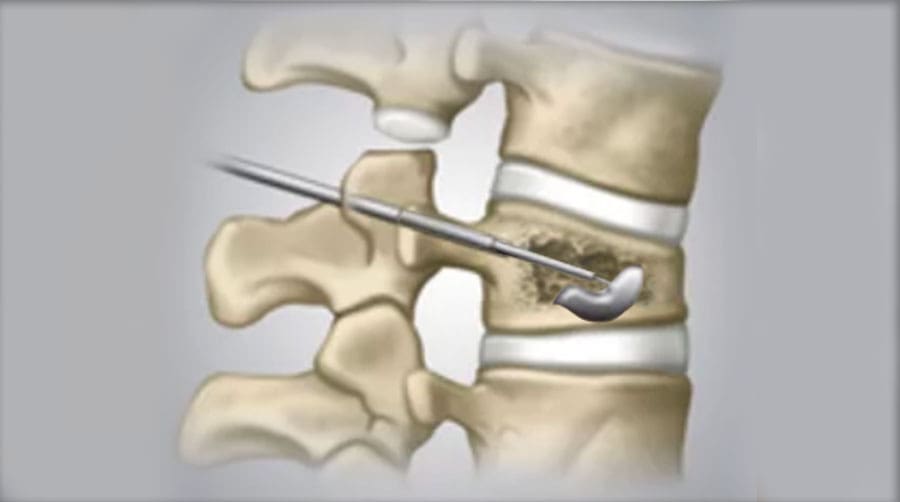Percutaneous Vertebroplasty
Percutaneous vertebroplasty is utilized for treating vertebral compression fractures, a prevalent cause of disability and pain. Annually, over 270,000 patients are diagnosed with a painful vertebral fracture in the USA alone, and this number is increasing. Osteopenia due to chronic steroid use, aging, and metastatic disease are some of the most common vertebral compression fractures. Patients with these fractures experience pain, which varies in duration and severity. Most of these patients are usually treated with traditional treatment, including analgesics, bed rest, and bracing, but some patients are left with limited mobility and continuous pain. Percutaneous vertebroplasty is a treatment meant for these patients.
Percutaneous vertebroplasty is an image-powered treatment where a fast-setting polymer or cement is administered into the damaged vertebral body. This procedure aims to alleviate disability and pain. This treatment is utilized to heal osteoporotic compression fractures, structurally compromised vertebrae, or pathologic fractures from underlying neoplasms. This procedure was initially described by Galibert, who deduced that PMMA or polymethyl methacrylate provides an internal casting when injected into the damaged vertebral haemangioma, thus giving patients immense relief from the pain. This treatment also reduces the dependency on analgesics and increases mobility while preventing vertebral collapse and other immobility-related complications.
Conditions that can be Treated with Percutaneous Vertebroplasty
The currently accepted conditions that can be treated with percutaneous vertebroplasty include:
- Osteoporotic vertebral compression fractures in the thoracic, cervical, and lumbar spine, causing mild to severe pain and is unresponsive to traditional therapy methods
- Multiple myelomas and painful metastasis without or with radiation or surgical therapy
- Vertebral osteonecrosis
- Painful vertebral hemangiomas
- Reinforcement of a weak vertebral body before the surgical stabilization treatment
How does Percutaneous Vertebroplasty Work?
Bone fragments are created when there’s a fracture or breakage in the vertebra. When these fragments rub or slide against each other or pinch into the spinal cord, the individual experiences a painful sensation. This treatment involves injecting the fractured bone with a mixture of cement polymer to fuse the broken fragments, strengthening the vertebra and thus giving the patient relief from pain. Initially, a local anesthetic is used to numb the skin over the affected area. Using imaging guidance, a hollow needle is inserted through the skin into the broken vertebra, and the cement mixture is injected.
What to Expect during Percutaneous Vertebroplasty Treatment?
A minimally invasive and image-guided procedure, percutaneous vertebroplasty is performed by a specially trained neuroradiologist or interventional radiologist. An IV line is inserted in the arm or hand of the patient to administer the sedative, as the procedure requires mild sedation.
The patient is made to lie face down for the procedure. The skin area through which the trocar or hollow needle is inserted is shaved, cleaned with a cleaning solution, and covered with the surgical drape. A local anesthetic is injected into the skin right above the fractured bone to numb the area. The physician makes a tiny incision at the site. The trocar is inserted through the spinal muscles using X-ray imaging guidance until the tip is positioned within the damaged vertebra.
The orthopedic cement is injected, which typically hardens within 20 minutes. Once the cement is injected, the trocar is extracted. CT scan or X-rays may be performed once the procedure ends to check whether the cement is well distributed. The physician applies pressure to avoid bleeding and closes the incision with bandages. The whole process takes around one hour; however, the time may increase if there is more than one fractured body.
Risks Associated with Percutaneous Vertebroplasty
Similar to all other treatments out there, certain risks are associated with percutaneous vertebroplasty, which include:
- Any invasive procedure where there is skin penetration has the risk of infection.
- Leakage of the orthopedic cement from the vertebral body. Though a rare and harmless risk, it can cause significant complications if the leakage moves near to blood vessels or the spinal canal.
- Other complications include increased back pain, infection, bleeding, and neurological symptoms like tingling and numbness.
- Paralysis in extremely rare cases
- Development of additional compression fractures
- Allergic reactions to medications
The treatment of percutaneous vertebroplasty strengthens and stabilizes the broken vertebral body but does not improve the shape or height of an already wedged or compressed vertebra. Such a condition is a sign of decreasing bone density and weak bones. Individuals who have experienced one compression fracture are at higher risk of developing another fractured vertebra. Thus, it is essential to find the underlying cause of weakened bones and treat it immediately.
Monarch Pain Management
Dr. Aaron Joseph is certified by the American Society of Regional Anesthesiologists. As proud as he is to be honored as the best pain management specialist, he has the vision to fulfill. The doctor aims at helping patients with chronic pain issues.
We provide effective treatments and therapies for pain management. Contact us now!
Online Appointment Scheduling
Schedule an appointment with Monarch Pain Management via our scheduling partner at growpractice.net. You can reschedule and cancel, as well.

Reclaim Your Mobility
Make an
Appointment


